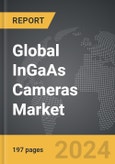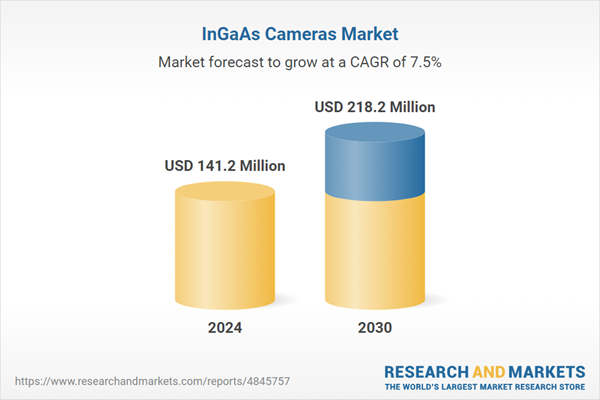The global market for InGaAs Cameras was valued at USD 141.2 Million in 2024 and is projected to reach USD 218.2 Million by 2030, growing at a CAGR of 7.5% from 2024 to 2030. This comprehensive report provides an in-depth analysis of market trends, drivers, and forecasts, helping you make informed business decisions.
Global InGaAs Cameras Market - Key Trends & Drivers Summarized
What Are InGaAs Cameras, and Where Are They Used?
InGaAs (Indium Gallium Arsenide) cameras are specialized imaging devices designed to capture light in the short-wavelength infrared (SWIR) range, typically between 0.9 to 1.7 microns. These cameras are invaluable in applications where traditional visible light cameras fail, such as in semiconductor inspection, solar cell evaluation, and agricultural sorting. The ability to see through certain materials and detect moisture or other chemical compositions makes InGaAs cameras essential in quality control processes in various industries. Moreover, their utility in military and defense applications for night vision and surveillance underscores their importance in scenarios where high-resolution and high-contrast imaging is critical.How Is Technological Advancement Shaping InGaAs Camera Development?
The development of InGaAs cameras is heavily influenced by advancements in sensor technology and materials science. Improvements in InGaAs sensor design have led to higher resolution and greater sensitivity cameras, enhancing their effectiveness across their application spectrum. The integration of cooling technologies has also improved the performance of these cameras in high-temperature environments, expanding their usability. Furthermore, as the technology matures, the cost of producing InGaAs cameras has decreased, making them more accessible for a variety of industrial and commercial applications. Innovations such as integration with artificial intelligence for image processing and analysis are further expanding the capabilities and applications of InGaAs cameras.What Challenges and Opportunities Do InGaAs Cameras Present?
While InGaAs cameras offer unique capabilities, they face challenges such as high initial costs and the need for specialized knowledge to operate and interpret the data they produce. However, these challenges present opportunities for growth and innovation within the sector. There is significant potential for developing more user-friendly InGaAs camera systems with enhanced data processing and analysis capabilities, which can open up new market segments. Additionally, ongoing research into alternative materials and improved sensor technologies promises to further reduce costs and enhance the functionality of these cameras.Growth in the InGaAs Cameras Market Is Driven by Several Factors…
The growth in the InGaAs cameras market is driven by several factors, notably the expanding range of industrial applications that require SWIR imaging for quality control and process monitoring. As industries continue to recognize the benefits of SWIR imaging in terms of non-destructive testing and online process control, the demand for InGaAs cameras is expected to increase. Technological advancements that enhance camera performance and reduce costs are also significant growth drivers. Additionally, the increasing adoption of advanced imaging solutions in the defense and security sectors provides a substantial market for InGaAs cameras. Environmental monitoring and agricultural applications, where SWIR imaging can be used to assess plant health and water status, represent emerging markets that are beginning to contribute to the growth of the InGaAs cameras sector. These diverse applications underscore the robust growth trajectory of the InGaAs cameras market.Report Scope
The report analyzes the InGaAs Cameras market, presented in terms of market value (USD Thousand). The analysis covers the key segments and geographic regions outlined below.Segments
Cooling Technology (Uncooled, Cooled); Scanning Type (Area Scan, Line Scan); Application (Military & Defense, Industrial Automation, Surveillance, Safety & Security, Scientific Research, Other Applications).Geographic Regions/Countries
World; United States; Canada; Japan; China; Europe (France; Germany; Italy; United Kingdom; and Rest of Europe); Asia-Pacific; Rest of World.Key Insights:
- Market Growth: Understand the significant growth trajectory of the Uncooled Technology segment, which is expected to reach $156.8 Million by 2030 with a CAGR of a 8.2%. The Cooled Technology segment is also set to grow at 5.9% CAGR over the analysis period.
- Regional Analysis: Gain insights into the U.S. market, valued at $38.2 Million in 2024, and China, forecasted to grow at an impressive 7.1% CAGR to reach $34 Million by 2030. Discover growth trends in other key regions, including Japan, Canada, Germany, and the Asia-Pacific.
Report Features:
- Comprehensive Market Data: Independent analysis of annual sales and market forecasts in USD from 2024 to 2030.
- In-Depth Regional Analysis: Detailed insights into key markets, including the U.S., China, Japan, Canada, Europe, Asia-Pacific, Latin America, Middle East, and Africa.
- Company Profiles: Coverage of major players such as AC Photonics, Inc., Allied Vision Technologies GmbH, Cosemi Technologies, Inc., Discovery Semiconductors, Inc., Edmund Optics, Inc. and more.
- Complimentary Updates: Receive free report updates for one year to keep you informed of the latest market developments.
Why You Should Buy This Report:
- Detailed Market Analysis: Access a thorough analysis of the Global InGaAs Cameras Market, covering all major geographic regions and market segments.
- Competitive Insights: Get an overview of the competitive landscape, including the market presence of major players across different geographies.
- Future Trends and Drivers: Understand the key trends and drivers shaping the future of the Global InGaAs Cameras Market.
- Actionable Insights: Benefit from actionable insights that can help you identify new revenue opportunities and make strategic business decisions.
Key Questions Answered:
- How is the Global InGaAs Cameras Market expected to evolve by 2030?
- What are the main drivers and restraints affecting the market?
- Which market segments will grow the most over the forecast period?
- How will market shares for different regions and segments change by 2030?
- Who are the leading players in the market, and what are their prospects?
Some of the 47 major companies featured in this InGaAs Cameras market report include:
- AC Photonics, Inc.
- Allied Vision Technologies GmbH
- Cosemi Technologies, Inc.
- Discovery Semiconductors, Inc.
- Edmund Optics, Inc.
- Episensors, Inc.
- Excelitas Technologies Corporation
- Fermionics Opto-Technology
- First Sensor AG
- FLIR Systems, Inc.
- GPD Optoelectronics Corp.
- Hamamatsu Photonics KK
- Ircamera LLC.
- Jenoptik AG
- Kyocera Corporation
- Laser Components GmbH
- Lumentum Holdings Inc.
- Luna Innovations, Inc.
- New England Photoconductor Corp.
- New Imaging technologies
- Photon Energy NV
- Precision Micro-Optics Inc.
- Princeton Instruments, Inc.
- QPhotonics, LLC.
- Raptor Photonics Limited
- Roithner Lasertechnik GmbH
- Sensors Unlimited Inc.
- Sofradir Group
- Teledyne Technologies Inc.
- Thorlabs, Inc.
- Voxtel, Inc.
- Xenics NV
Table of Contents
I. METHODOLOGYII. EXECUTIVE SUMMARY2. FOCUS ON SELECT PLAYERSIII. MARKET ANALYSISIV. COMPETITION
1. MARKET OVERVIEW
3. MARKET TRENDS & DRIVERS
4. GLOBAL MARKET PERSPECTIVE
UNITED STATES
CANADA
JAPAN
CHINA
EUROPE
FRANCE
GERMANY
ITALY
UNITED KINGDOM
REST OF EUROPE
ASIA-PACIFIC
REST OF WORLD
Companies Mentioned (Partial List)
A selection of companies mentioned in this report includes, but is not limited to:
- AC Photonics, Inc.
- Allied Vision Technologies GmbH
- Cosemi Technologies, Inc.
- Discovery Semiconductors, Inc.
- Edmund Optics, Inc.
- Episensors, Inc.
- Excelitas Technologies Corporation
- Fermionics Opto-Technology
- First Sensor AG
- FLIR Systems, Inc.
- GPD Optoelectronics Corp.
- Hamamatsu Photonics KK
- Ircamera LLC.
- Jenoptik AG
- Kyocera Corporation
- Laser Components GmbH
- Lumentum Holdings Inc.
- Luna Innovations, Inc.
- New England Photoconductor Corp.
- New Imaging technologies
- Photon Energy NV
- Precision Micro-Optics Inc.
- Princeton Instruments, Inc.
- QPhotonics, LLC.
- Raptor Photonics Limited
- Roithner Lasertechnik GmbH
- Sensors Unlimited Inc.
- Sofradir Group
- Teledyne Technologies Inc.
- Thorlabs, Inc.
- Voxtel, Inc.
- Xenics NV
Table Information
| Report Attribute | Details |
|---|---|
| No. of Pages | 197 |
| Published | April 2025 |
| Forecast Period | 2024 - 2030 |
| Estimated Market Value ( USD | $ 141.2 Million |
| Forecasted Market Value ( USD | $ 218.2 Million |
| Compound Annual Growth Rate | 7.5% |
| Regions Covered | Global |









